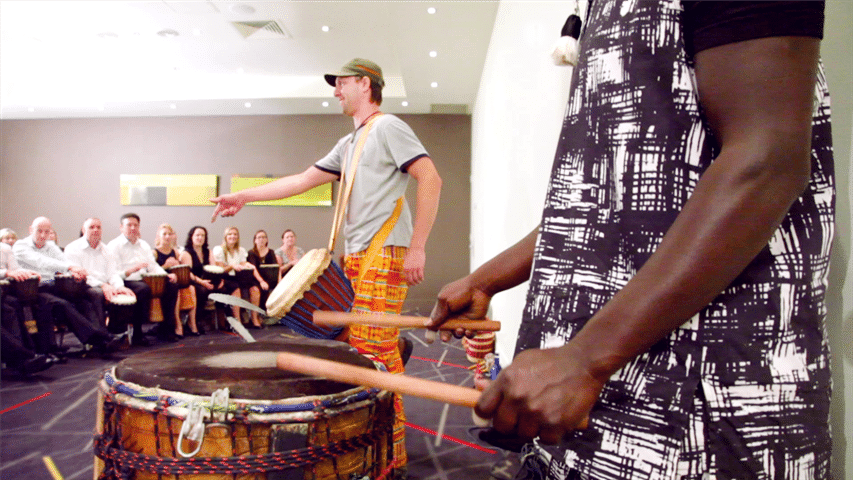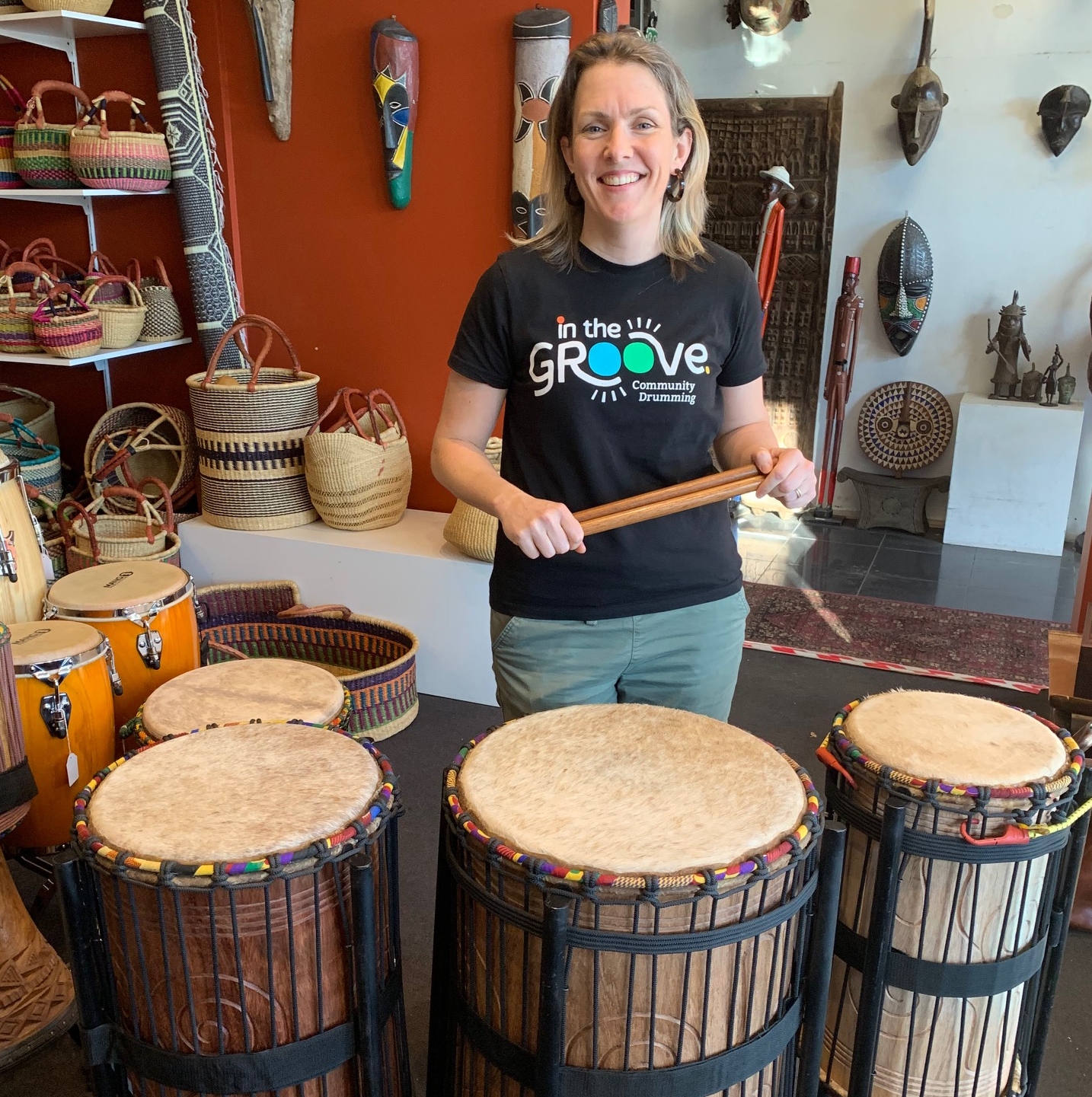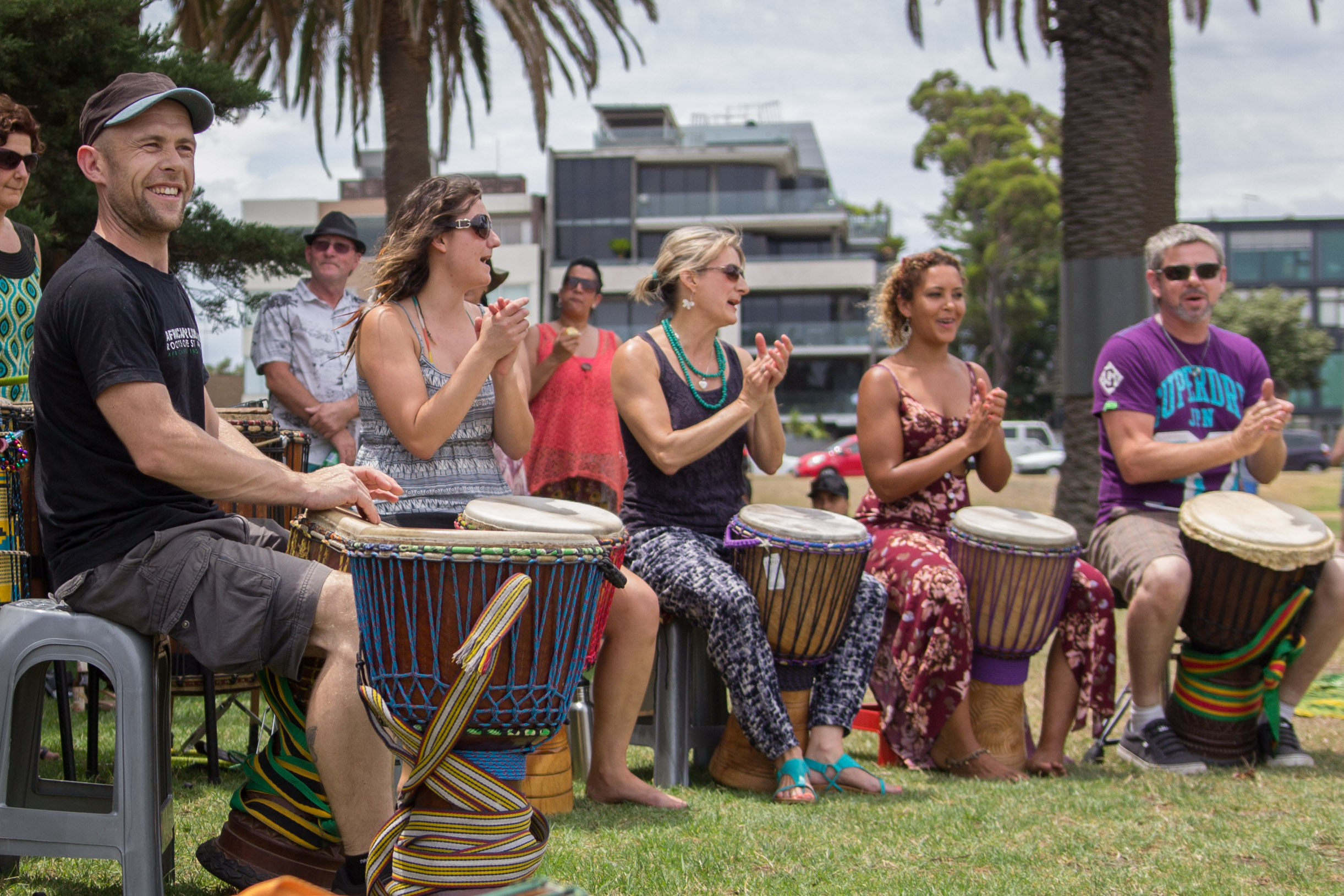
First time drummer Corrina came into the store last week and bought a djembe, a set of bongos AND a darbuka! Thanks so much for coming in Corrina, you’re in for a treat with all those instruments! ?
Shop our online store now.

First time drummer Corrina came into the store last week and bought a djembe, a set of bongos AND a darbuka! Thanks so much for coming in Corrina, you’re in for a treat with all those instruments! ?
Shop our online store now.
Our school and kinder workshops are an immersive, educational experience for students of all ages and backgrounds. We bring the rich culture of West Africa to each and every classroom through drumming, dancing and singing. Check out our new video below for more information.

Mindfulness is a mental state in which you’re totally focused on the present moment. It offers a clarity and sharpness of thought that provides, at the very least, a temporary reduction in stress. This mental exercise enables you to achieve a greater emotional balance. What’s more, experts have found that mindfulness can even reduce physical pain and mental depression. For the middle aged or elderly, mindfulness activities can help to keep the brain sharper for longer. There are many ways of achieving mindfulness. You might get there through practiced breathing techniques, yoga, relaxation practices or meditation, among other methods. But did you know that musical rhythm is another effective way to tap into mindfulness?
TRM And It’s Benefits
Therapeutic Rhythm and Mindfulness, also known as TRM, represents ways of getting to a state of mindfulness through group drumming or other forms of rhythmic musical expression. The goal of TRM is to sharpen your consciousness and strengthen your sense of social connection by incorporating drumming skills into a group dynamic. It’s not easy. It requires concentration, focus and an awareness of others – all of which are fundamental capabilities for strong mental health. Not only do you stand to gain these valuable benefits, but group drumming is fun!
Discover Your Place In The Present
The concept of TRM involves fully cultivating your awareness of the present moment. With your focus completely within the now, you begin to realize that the present moment is the only place where reality unfolds. This helps you avoid dwelling in thoughts about the past or future that don’t serve a purpose. Living in the present moment may relieve you of dark memories that you could have collected as unwanted baggage, or of the tension of
tomorrow’s expectations upon you. As long as you’re sharing in the rhythm, your mind will stay in the here and now. It’s a challenge, finding and maintaining this group rhythm. While you’re facing this challenge, there’s no time for stress or anxiety. You lose all concern about a fight with someone or the bills due tomorrow. There’s only your sharp focus on the rhythm to maintain. Your only responsibility is to add
to the collective sound of those within your new and present social network.
The Cognitive Benefits Of Drumming
Repetitive drumming puts us in a relaxed state of mind in much the same way that meditation or breathing exercises provide focus and stress relief. In all cases, we have no time for alternate situations as we concentrate on what we’re doing in the moment. The way that group drumming allows you to express yourself creatively is just as beneficial to your brain as if you’d taken up the violin, oil painting or poetry writing.
Creative expression, social acceptance and connectivity can be the result of group drumming. TRM has scientific support. The exercise sends messages through the neural pathways of the brain that can be adversely affected by negative emotions such as fear, stress and anxiety. And, as in all mindfulness exercises, it can slow the thinning of the frontal cortex of the brain that occurs with age and results in forgetfulness.
The Social Side Of Group Drumming
The social aspect of drumming within a group environment sharpens acuity and is as beneficial as a shared activity as meeting others regularly in a book group, chatting every morning over coffee or playing horseshoe once a week. Studies have shown that social interaction provides as much protection against dementia and Alzheimer’s disease as a good diet, regular exercise and mental workouts. Drumming
and other forms of musical expression are mental workouts in their own right.
Drumming also taps into the innate human need to play. It’s easy to underestimate the importance of play in life. Whether you’re nine or ninety, you need to experience the joy, humor and sense of shared experience that play brings us. Music-making delivers that state of playfulness in spades. Creative expression in a group context can bring you out of the wilderness if you’re experiencing loneliness, depression, anxiety, grief or social awkwardness. TRM through group drumming can help you claim a space in your life where you feel you truly belong – and benefit your brain and physical well-being in the process.

Aleisha Leonard came in last week and picked up a beautiful gudu handpan. Aleisha teaches yoga and was looking for the perfect accompaniment to her sessions. The handpan is a new and mysterious instrument, distantly related in principle to the steelpan of Trinidad and Tobago, but inspired in sound by the Hang of Switzerland. Played by hand, the handpan has a rich, intimate sound and is full of emotion. There is no specific technique or style in the art of playing and a player with patience and an open mind will be rewarded over time with this complex and beautiful instrument.
Our selection of handpans can be viewed here.

So much has been said about the many ways in which new technologies steal our attention, changing our ability to focus on doing one thing at a time, or our ability to do nothing at all. We play with our phones while watching television and we look at our screens whenever we finally have a quiet moment. Many adults struggle with gaining their attention back. Some embark on a ‘digital diet’ or swear off screens at certain times of the day. If adults who grew up during quieter times find it hard to disconnect, how can we teach children, born into a world of constant
distractions, to focus on the moment and be able to give attention to just one thing for more than a few minutes?
These are increasingly important skills to have, in every area of life. Children naturally have shorter attention spans than adults, however growing up in an environment that constantly offers distractions can have a major impact on their ability to focus, as well as their ability to develop attention skills as adults. It’s also important for children to be able to get bored, as it develops their understanding of what they really enjoy doing. In addition, it opens a space for creativity to flourish and it allows for time to reflect, calm down, or process feelings and events.
So how can we develop children’s focus in a world of constant distractions? One way to do it which has been widely researched and discussed, is mindfulness: the act of purposefully giving attention.
Mindfulness is gaining huge popularity among parents and educators alike, and has been integrated across kindergartens and schools. Another great tool is to offer activities that are fully engaging, so that children focus on them without even trying; instead they just find themselves enjoying and being in the moment. Even better is combining the two: finding activities that offer both total immersion and engagement together with elements of mindfulness. These types of activities can be incredibly powerful for children. Often, these activities will include repetitive or rhythmic elements; they will offer the child the opportunity to be a part of a team, while still allowing for self-expression and creativity; and will provide constant learning and growth without being too challenging. Some of the best options for these types of activities are dance or music-based workshops, especially accessible and inclusive ones. For example, African drumming is an incredibly accessible form of music playing – within a minute of being introduced to the hand drum, anyone can follow a rhythm. It isn’t challenging at all to begin to play, however it offers a constant learning curve that keeps the child engaged. The repetition within the rhythm is a powerful tool for encouraging mindfulness, offering the same focus that is given to the breath in meditation practices. African drumming is best played in a group, demanding that attention is given to the rest of the players and to the rhythms played together; at the same time, students can also find space for self-expression and creativity and be given opportunities to solo or improvise. This also means that children will need to listen, follow and respond to the improvisation of other children. This is an important element as it demands that the child does not lose themselves in their own experience, but instead stay attuned to the group.
Drumming on djembes – the African hand drums – is a physical activity which provides a variety of tools for expanding the mindfulness experience. For example, students can focus on the movement of their hands, or they can practice breathing through vigorous drumming. The physical element of drumming also helps in diminishing signs of restlessness and relieving anxiety or stress, just as other forms of physical workouts offer. The stress relieving also helps in regaining focus and staying in the moment. The accessible and engaging qualities, together with the mindfulness elements of African drumming, demonstrate that attention can be gained and practiced in meaningful experiences, away from the screens and for substantial periods of times. Nowadays, when attention is an art that needs constant practicing and reinforcing, it is an incredibly valuable instrument.
We were lucky enough to have the amazing Kofi Nortey drop by and treat us to a beautiful Ghanaian song. This song is a traditional ballad about purification and Kofi’s voice couldn’t be more pure! Check out the video of Kofi and Simon (on talking drum) below.

We all know that child — the quiet one that likes to sit at the back and observe. Many children are scared to try new things and are particularly anxious around large groups. There’s a shy kid in every class and even the most thrilling class activities seem to overwhelm them. As a teacher, it’s important to encourage participation in healthy ways, because we know from experience that forcing someone to speak up or take leadership can often be counter-productive.
The long term benefits of group activities are endless – teamwork and leadership skills, adaptability, awareness – as are the disadvantages of not participating. Experimenting in group activities can help shape someone’s interests and passions, boost confidence and encourage healthy social relationships in and outside of the classroom. Similarly, if someone routinely refuses to engage in group activities this will surely affect their individual growth. Participating in groups as a young child can lay a lot of groundwork for healthy development. Creativity, Leadership, Confidence, Mindfulness, Communication, Team Work and Inclusiveness are all fundamental assets that can be developed and mastered through group interactivity, and if a child disengages it may be harder for them to grasp and perfect these later in life.
Music therapy is a common tool used in playrooms and classrooms, as it can affect mood, relieve stress, improve motor skills and connect the individual with his/her external reality. Music and dance are popular non-verbal universal languages that bring participants together, regardless of age, gender, backgrounds and barriers. African Drumming in particular is a perfect example of this and the body of research and quantifiable data on the benefits of drumming have boomed in the last 15 years, spurred on by the djembe’s (West African hand-drum) growing popularity across the world. Drumming has proven itself as a powerful stress-relieving and mindfulness activity, and is almost always performed in a group. Now, let’s look at those assets above and their relationship with African Drumming.
Creativity is an integral part of African Drumming. The accessibility of African drumming allows children to express their creativity in an open safe space to drum, dance and sing, alongside their friends and teachers. It’s a communal activity and children will be encouraged to play in small groups, as well as individually. All children – no matter their background – will have the opportunity to improvise and exercise their individual flair, offering even the shyest of children the space to express themselves in whichever way they feel comfortable with.
Children will be assigned to lead different parts of an ensemble rhythm, allowing them the space to exercise Leadership. Even if one particular child doesn’t initially want to be in a position of leadership, they can still play an integral role in the ensemble. They’ll also have the opportunity to observe their peers in different roles of leadership before deciding if they wish to be more dominant in the group. It might also be easier for a more passive child to take centre stage if they witness children of their own age and skill level in a position of leadership within the ensemble.
Confidence is gained and nurtured through African Drumming when a child feels like they have control over their instrument, and particularly when they feel their contribution and presence is valuable in the group. The great thing about African drumming is that it’s an incredibly accessible form of music playing — within a minute of being introduced to the hand drum, anyone can follow a rhythm. It isn’t challenging at all to begin to play, however it does offer a constant learning curve that keeps children engaged. The ability to acquire a new skill is empowering, especially for a developing child.
An important meditative tool, African Drumming is advantageous in developing Mindfulness in young children. It forces participants to be present and focus on the music, the drum, their hands and their peers, while also promoting internal self-awareness. It can be quite detrimental if a child feels like they are lagging behind or letting their team down, and fortunately the intrinsic nature of African Drumming makes it very difficult for participants to detach or become distracted.
Communication can be utilised in new and interesting ways through African Drumming. If children don’t feel comfortable using their voices in group activities, they can express themselves instead through drumming. When participants drum together, they communicate and connect through the language of the drum. The leader communicates all their cues through the drum and the group responds by following the rhythms.
Team Work and Communication are very similar in African Drumming. The non-verbal nature of the activity means that individual members are communicating to each other and to their leader through rhythms. The innate position of African Drumming as a communal activity means that children will automatically feel like they are part of a team, working together to create one beat.
Inclusiveness is fundamental to African Drumming. Everyone within an ensemble has a key part to play, whether you’re leading or responding. Drumming doesn’t care where you’re from or what language you speak — it’s all about the music. To reiterate, African drumming is a communal activity – it depends on participants playing off one another – and children may feel more inclined to participate if they feel as though they’re needed.
African Drumming’s proven benefits and its relationship with education distinguishes it as a powerful tool in development, particularly early childhood development. Its fundamental communal nature fosters Creativity, Leadership, Confidence, Mindfulness, Communication, Team Work and Inclusiveness in ways that will encourage even the quietest child in class to dip their feet in, one toe at a time.
Effects of Community African Drumming on Generalised Anxiety in Adolescents
By David Akombo
African drumming as a medium to promote emotional and social well-being of children aged 7 to 12 in residential care
By Kim Flores
The Impact of Group Drumming on Social-Emotional Behavior in Low-Income Children
By Ho et al
Bassidi (balafon), Mohamed (kora & vocals), Boubacar (dununs) and Simon (talking drum)

Emma came in a couple of weeks ago and bought our set of Black Thunder dununs from Ghana.
“I need to practice more so I can improve! Plus, they bring me so much joy.”
Thanks for coming in Emma, good luck with your practising and we hope you enjoy!
Check out our range of dununs here

22 trees and counting! Our tree-planting project with Ghanaian NGO company Denyigba Lorlor has been picking up momentum recently — for every African drum we sell here at the store, we organise the planting and nurturing of a new hardwood tree in Ghana. Our partnership with Denyigba is focused on forest regeneration and we’re so thrilled to see that our little project is going so well.
On May 1, the whole community of Denyigba united and planted trees together — witnessing a beautiful collaboration of villagers, young and old. Denyigba Lorlor also works with Dream Big Ghana, a similar minded NGO focused on improving sanitation and education in Ghana.
???
Kofi Kunkpe road tests our brand new shipment of half Calabash gourds from Niger, West Africa.
A new weekly series showcasing a different instrument available in-store and online
This week: Our director Simon takes a stab at his own ASMR video with an Ocean Drum

Keeping in line with Earth Day and our ongoing sustainability initiative, we’ve partnered with two different tree planting initiatives in Ghana and Indonesia.
In Ghana, our joint venture with registered NGO Denyigba Lorlor involves reforesting hardwood mahogany: for every African drum we sell, we plant and nurture a new hardwood tree.
Our Indonesia partnership is with the East-Java Plant a Tree Program: 5% of revenues from our Indo djembes will be donated to this foundation.
???

Narelle came all the way from NSW on recommendation from her drum circle group and teacher, braving the Melbourne heat to pick out a drum to suit her. She ended up choosing a beautiful second grade djembe from Ghana. Thanks Narelle!
Our second grade djembes can be viewed here
A new weekly series showcasing a different instrument available in-store and online
This week: Our director Simon road tests our brand new handpans
A new weekly series showcasing a different instrument available in-store and online
This week: Mike & Frank play the guiro (Mike, right) and thumb bells (Frank, left)
A new weekly series showcasing a different instrument available in-store and online
This week: Simone and Mike play the small djembe cajon (Simone on the left) and the classic cajon (Mike on the right) – A cajon drum is a box-shaped percussion instrument originally from Peru, played by slapping the front face with the hands.
New friend to AD, Adam picked up a monster 15.5″ Master series Guinea lenke djembe last week. Originally a darbuka player, he wanted a drum with sharp slaps and a big bass. The master series are our top line djembes, boasting immaculate, faultless shells, pure tonal range and formidable projection. Check them out here.
A new weekly series showcasing a different instrument available in-store and online ?
This week: Mike and Franky play the tongue drum – a small acoustic drum (also known as a contemporary West African log drum). Easy for anyone to play this drum produces a warm melodic sound.

For over ten years we’ve been working with the team at Counterpart – supporting woman with breast cancer through the power of African Drumming. We love our annual visit and always come away uplifted by the happy faces.
Here’s some more research on the benefits
http://bit.ly/DrummingForBreastCancer